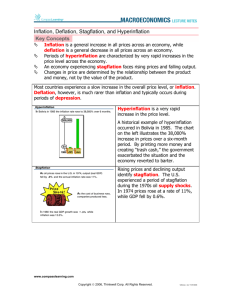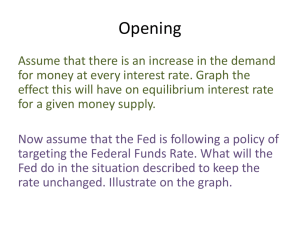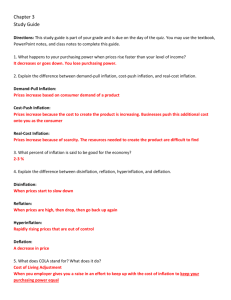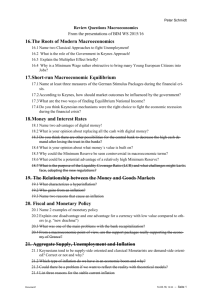Money and Inflation
advertisement
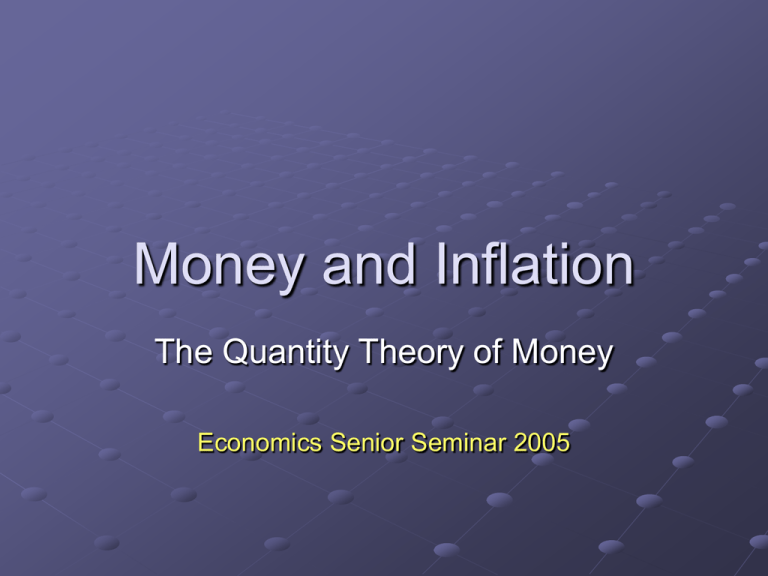
Money and Inflation The Quantity Theory of Money Economics Senior Seminar 2005 The “Equation of Exchange” MV = PY Money supply x velocity = price level x income We can treat velocity as fairly constant We know that income is affected by real inputs like the availability of labor, capital, and technology—not the money supply 2 Velocity Source: Mankiw, Principles of Macroeconomics, 3rd ed. (2004), instructor ancillaries 3 Money Supply and Prices MV = PY If velocity is constant and income is not determined by the money supply (in the long run), then: All that’s left is M and P, and they have to move together. When M↑, P↑. 4 Money Supply and the Price Level Source: Mankiw, Principles of Macroeconomics, 3rd ed. (2004), instructor ancillaries 5 Money Supply and the Price Level Source: Mankiw, Principles of Macroeconomics, 3rd ed. (2004), instructor ancillaries 6 Early Keynesians Early Keynesians suggested that apparent money supply increases were ineffective in stopping the Great Depression During the Depression, rates on U.S. Treasury securities dropped very low Investment also stayed low despite low interest rates Fiscal policy was their prescription 7 Early Monetarists In the 1960s, the monetarists showed that Depression-era monetary policy was contractionary, and that real interest rates were actually considerably higher than the Keynesians had indicated. They concluded that in the short run, the Fed should have increased the money supply to counteract the contraction caused by bank failures, etc. 8 Costs of Inflation “Shoeleather costs” With higher interest rates, the opportunity cost of holding money is higher So people make more frequent transactions with a bank to hold lower average money balances 9 Costs of Inflation Menu costs Inflation means that firms have to change their nominal prices more often Print and mail new catalogs Communicate new prices to sales force 10 Costs of Inflation Changing relative costs Not all prices change at the same rate—some are “stickier” than others Therefore, relative prices change Price level increase People switch from apples to pears— decisions are distorted! Apples Pears 11 Costs of Inflation Price “stickiness” is not the only reason for relative price changes Where the new money enters the economy is important. If the government spends the new money first, then the things government buys will see price increases first Who gains? People who sell to the government Who loses? People who are in competition with the government, who buy what it buys 12 Costs of Inflation Changing relative costs Price of a good may fall out of step with inflation over time, so that sales timing is distorted Relatively high Price increase price—sales low Relatively high price—sales low Price level Price of widgets Relatively low price—sales high Time 13 Costs of Inflation Loss of information Inconveniences associated with a changing standard 14 Costs of Inflation Unexpectedly high inflation is redistributive With fixed interest rates, lenders lose, as purchasing power of repayment is lower than was anticipated. Borrowers gain Unexpectedly low inflation redistributes as well Lenders gain, borrowers lose 15 Costs of Inflation Inflation can create business cycles Pushing interest rates down can create the impression that long-term projects are more profitable People invest in those long-term projects by buying capital for them When the interest rate comes back up from its artificially low levels, the capital investments lose value Stock prices drop, people are laid off. 16 Inflation and Business Cycles Increase in willingness to save vs. Increase in money supply Interest rate S S’ Interest rate i i i’ i’ S Unsustainable separation of saving & investment D S=I S’=I’ Loanable funds S+M D S’ S=I I’ Loanable funds 17 Hyperinflation in Germany At the end of World War I, Germany was required to pay reparations to the Allies Germany began running large deficits Unable to tax or borrow enough to pay, Germany began printing large quantities of money. Prices started to rise. 18 Hyperinflation in Germany Price of a newspaper in Germany, 1921-1923: Source: Mankiw, Macroeconomics, 5th ed., pp. 105-106 Date January 1921 May 1922 October 1922 February 1923 Price in marks 0.30 1 8 100 September 1923 1,000 October 1, 1923 October 15 October 29 2,000 20,000 1,000,000 November 9 November 17 15,000,000 70,000,000 19 Hyperinflation in Germany 20 Hyperinflation in Germany Source: Mankiw, Principles of Macroeconomics, 3rd ed. (2004), instructor ancillaries 21 Hyperinflation in Germany Fiscal reform ended the inflation At the end of 1923, the number of government employees was cut by a third A new central bank was created This demonstrated a commitment to not printing money Source: Mankiw, Macroeconomics, 5th ed., pp. 105-106 22 Hyperinflation in Yugoslavia From 1971-1991, Yugoslavia had an average annual inflation rate of 76% Only Zaire and Brazil had a higher inflation rate. In December 1990, the Serbian parliament ordered the Serbian National Bank (a regional central bank) to issue large amounts of credits to friends of Slobodan Milosevic. Source: Steve Hanke in April 28, 1999 Wall Street Journal 23 Hyperinflation in Yugoslavia This amounted to more than half the planned increase in the money supply for all of Yugoslavia in 1991 Croatia and Slovenia broke away In January 1992, hyperinflation began Source: Steve Hanke in April 28, 1999 Wall Street Journal 24 Hyperinflation in Yugoslavia In January 1994, the official monthly inflation rate reached 313 million percent This was the second-highest monthly rate (after Hungary in 1946) …and the second-longest (after the Soviet hyperinflation of the early 1920s) People spent their time trying to exchange dinars for marks or dollars on the black market Source: Steve Hanke in April 28, 1999 Wall Street Journal 25 Hyperinflation in Yugoslavia The Yugoslav mint was producing 900,000 bank notes a month, in denominations of up to 500 billion dinars Source: Steve Hanke in April 28, 1999 Wall Street Journal; image from National Bank of Serbia 26 Hyperinflation in Yugoslavia On January 6, 1994, the government gave up and declared the German mark legal tender Tying a “superdinar” to the mark reduced inflation Source: Steve Hanke in April 28, 1999 Wall Street Journal 27 Three Other Hyperinflations Austria (1921-1923) Hungary (1921-1924) Poland (1922-1924) 28 Hyperinflation in Austria Source: Mankiw, Principles of Macroeconomics, 3rd ed. (2004), instructor ancillaries 29 Hyperinflation in Hungary Source: Mankiw, Principles of Macroeconomics, 3rd ed. (2004), instructor ancillaries 30 Hyperinflation in Hungary 1946 hyperinflation was even worse Resulted in largest denomination note ever issued by any country: 100 Million Bil-Pengo (1946): 100,000,000,000,000,000 units Image source: Tom Chao’s Paper Money Gallery: http://www.tomchao.com/eu/eu29a.html 31 Hyperinflation in Poland Source: Mankiw, Principles of Macroeconomics, 3rd ed. (2004), instructor ancillaries 32 Inflation Today Consumer Price Inflation Rates, 1984-2003 1984-1993 1994-1998 1999-2003 2003 US 3.8 2.4 1.8 1.7 Advanced economies 4.2 2.2 1.8 1.7 Developing 48.5 countries 22.9 6.1 6.0 Transitional 72.8 economies 100.0 20.1 8.8 Source: http://business.baylor.edu/Steve_Gardner/LECOUT02c.html 33 Inflation Today HIGHEST INFLATION3: 2003 1. Zimbabwe 383.4% 2. Angola 106.0 3. Myanmar 52.8 4. Haiti 37.3 5. Venezuela 31.1 6. Belarus 30.0 7. Iraq 27.5 8. Malawi 27.4 9. Ghana 26.4 10. Uzbekistan 21.9 Source: http://www.infoplease.com/ipa/A0762380.html 34 Stopping Inflation Preserve alternative means of raising funds Price controls Hidden inflation—monetary price increases but is not measured Black market transactions Hidden quality deterioration Repressed inflation—shortages and queues develop Central bank independence More independent central banks produce less inflation Source: http://business.baylor.edu/Steve_Gardner/LECOUT02c.html 35 Stopping Inflation Currency boards Link currency to a trusted foreign currency Can still fail (Argentina) Commodity standard Historically—metals, tobacco, real estate… 36 Price Stability To minimize uncertainty, Friedman and others have suggested a fixed money growth rate rule. New classicals: active monetary and fiscal policy is generally a bad idea. However, even countries that have required their central banks to follow such rules have allowed them some discretion—because it is understood that money growth will have a short-run impact. 37 What About Gold? What if the U.S. were to return to a gold standard? Central bank, and/or private banks, would be required to exchange dollars for gold at a fixed rate Appeal: nature fixes supply of gold, not subject to political whim 38 What About Gold? David Ricardo (1817): “Though it (paper money) has no intrinsic value, yet, by limiting its quantity, its value in exchange is as great as an equal denomination of coins…. Experience, however, shows that neither a state nor bank ever has had the unrestricted power of issuing paper money without abusing that power… 39 What About Gold? David Ricardo (1817): “…in all states, therefore, the issue of paper money ought to be under some check and control; and none seems so proper for that purpose as that of subjecting the issuers…to the obligation of paying their notes either in gold coin or bullion.” 40 What About Gold? Problem 1: what about the official dollarto-gold ratio? Inflation can occur even under a gold standard Altering the ratio has been done Jan. 31, 1934: FDR changed the dollar from $20.67 per ounce to $35 per ounce Devaluation may impose a credibility cost… but some avoid announcement and allow black markets 41 What About Gold? Problem 2: what about emergencies when the government leaves the gold standard? This has been done 1933: FDR prohibited withdrawals of gold or silver 1971: Nixon ended the last vestiges of the gold standard by preventing foreign central banks from “cashing in” their dollars for gold 42 What About Gold? Gold standard is not foolproof guard against untrustworthy governments --But inflation has been higher without it! 43 What About Gold? Inflation can still occur under a gold standard When Spain imported gold and silver from the New World, the money supply in Europe tripled. Spanish prices were 340% higher in 1600 than they had been in 1500 England had a price increase of almost 260% France had a rise of about 220% This is still far less than even the relatively lowinflation US in the 20th century 44 Main Points Increases in the money supply produce increases in prices Price increases cause misallocation of resources Inflation might be reduced by preserving alternative means of raising funds central bank independence tying currency to a foreign currency, or a commodity standard 45

